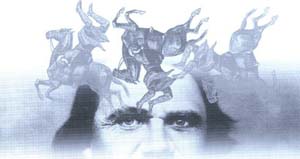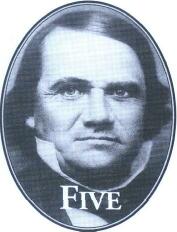|
C U R R I C U L U M M A T E R I A L S
|
|
Bill Ulmer
|
Overview
Main Ideas
Explore the reasons that Stephen A. Douglas presented and promoted the Kansas-Nebraska Act of 1854. By studying the Kansas-Nebraska Act, the students will get a feeling of this period of history. Students will study some major events leading up to the act and events afterwards that were affected by the act. In doing all of this, students will analyze the changing role of political parties in America.
Connection with the Curriculum
This material may be used to teach lessons in the following classes: U. S. history, sociology, government, social studies, or language arts. The activities may be appropriate for the Illinois Learning Standards
14.C.3; 14.D.4; 14.D.5; 14.F.4a; 14.F.5;
15.B.4b; 15.C.4a; 16.A.3a; 16.A.3b; 16.A.3c;
16.A.4a; 16.A.4b; 16.A.5a; 16.A.5b;
16.B.5a(U.S.); 16.C.3b(U.S.); 17.C.3a.
Teaching Level
Grades 8-12
Materials for Each Student
• A copy of the narrative portion of this article
• Various documents from this period of history
• The student's history book
• Activities 1 through 4
• Additional reference material as needed
and modeling of material
Objectives for Each Student
• Understand how historical events relate to and affect each other
Missouri Compromise
Kansas-Nebraska Act of 1854
The Lincoln-Douglas Debates as part of the election for the Senate in 1858
The campaign for and the election of president in 1860
• Explore the possible reasons that Stephen A. Douglas promoted the Kansas-Nebraska Act of 1854
• Analyze the role of political parties and how they have changed over time
• Demonstrate how events do not always work out the way historical figures hope and plan they will
• Investigate how events can determine how politicians react to the issues
• Analyze how a person's views can be formed and presented
|
SUGGESTIONS FOR TEACHING THE LESSON
|
Opening the Lesson
Have the students read the article. Discuss various parts of the article with the students. Assign the activities you believe will be best for your students.
Developing the Lesson
• See the headings at the start of Activity 1, Activity 2, Activity 3, and Activity 4.
• Activity 1 will allow the students to see how historical events affect each other.
• Activity 2 will help the students improve their ability to develop and defend their ideas.
• Activity 3 will allow students to work together to develop their ideas by using the article and oral history.
• Activity 4 provides the students with an opportunity to see how ideas develop and to show what really happened in history through a less traditional way to express themselves.
Concluding the Lesson
The students and teacher could discuss some of the ideas that have been developed in the various activities. This could lead to a discussion of contemporary politics and how politicians make decisions in today's world. During this discussion the teacher should make every effort to promote and develop the student's use of critical thinking and expression.
Extending the Lesson
The students should take every opportunity to use their school's computer lab and the information available on the Internet. In so doing they should consider making the information they have developed available to others. There are a number of places where this could be accomplished. One of these is Historic Illinois at < http://www.historicillinois.com/.> Some of the activities the students have developed in this unit could be the start of a Illinois History Fair project in any of the following categories: research papers, media, performance or exhibits.
Assessing the Lesson
Individual teachers could use a variety of ways to assess the particular activities they have selected to use in their classroom. Just a few are mentioned here. Activity 1 and 2 use a written essay. Each teacher would want to make his or her own rubric to check the particular thing he or she wants to accomplish. This would also be true of the oral report in Activity 3. A possible grading scale for Activity 4 is provided and presented.

Can we work it out?
8

Using your history textbook as a starting point, show how major events in history do not stand alone. Students may expand this lesson by doing additional research on these four major events that contributed to the causes that led to the American Civil War. Students are to show how one event affects or contributes to the next event. Students should consider the information presented in the narrative portion of this article and then expand on it. Events that should be included in their essays are:
1. Missouri Comprise
2. Kansas-Nebraska Act of 1854
3. The Lincoln-Douglas Debates as part of the election for the Senate in 1858
4. The campaign for and the election of the president in 1860
9


FIVE
POSSIBLE
REASONS.
|
Using the narrative portion of the article as a starting point, students are to find and explore the five possible reasons that Stephen A. Douglas acted as he did in proposing and working for the passage of the Kansas-Nebraska Act of 1854. In essays they should discuss the pros and cons of each possible reason for his action. In conclusion they should state why they think he acted as he did.


The narrative portion of the article mentions the importance and functions of political parties during Stephen A. Douglas's time. Has this changed over time, and if so, how?
FOR THIS PROJECT:
A. Divide the class into groups.
B. Have each group contact a local member of a political party and research the functions of the modern-day political party.
C. Each group should then make a report on their findings to the class. This report should or could consider the following things:
1. The information presented in the narrative portion of the article about political parties in Stephen A. Douglas's time.
2. What were the differences between the sections of the country in Douglas's time?
3. Do we still have differences between the sections of the country today? If so, what are they?
4. What do the students see as the functions of a political party?
5. What do the students think the functions of a political party should be?
11


What did Douglas want?
|
A. MAIN IDEA
Using some form of presentation to the class, the students are to show what Douglas wanted to happen in Kansas and Nebraska and why he thought popular sovereignty was a sound idea based on Democratic principles. In the second part of this presentation they should show what actually happened in Kansas and Nebraska and why they think it happened this way.
B. PROCEDURE
1. This project may be of any type, but it must be oral or visual. Types of presentation could include live skits, debates, videos, pictures, cartoons, etc.
2. The project must display history in a completely accurate sense.
3. Total time limit for this activity is ten minutes.
4. The maximum size of the groups is four students.
5. You will be given one class period to organize your ideas. The rest of the work will be completed outside of class.
6. Make them good, and the rest of the class will learn from them.
C. HOW THE PROJECT COULD BE GRADED
Area covered
Douglas's plan
Popular sovereignty
What actually happened?
Why it happened?
Accurate use of history
Skill of presentation
Creativity
|
Possible Points
10
10
10
10
20
20
20 | |
Total Points = 100
|
Click here to return to the article
12
|




